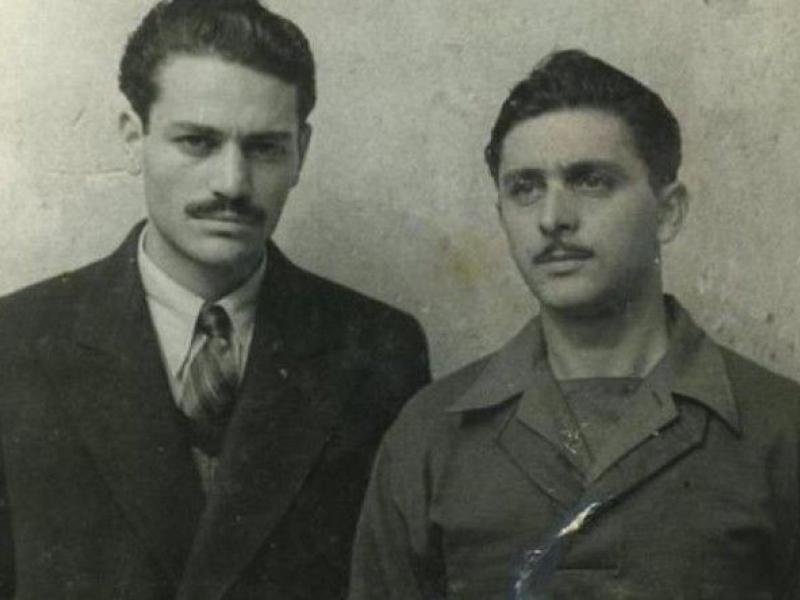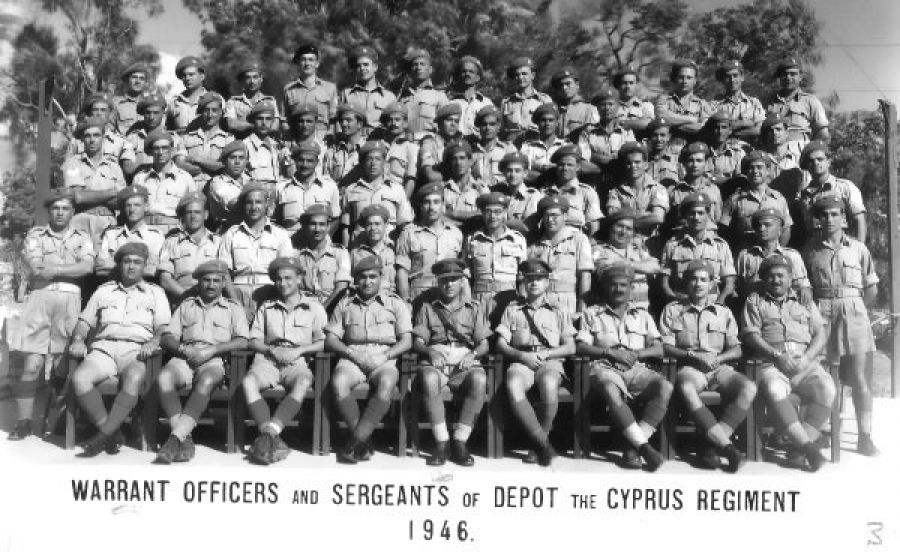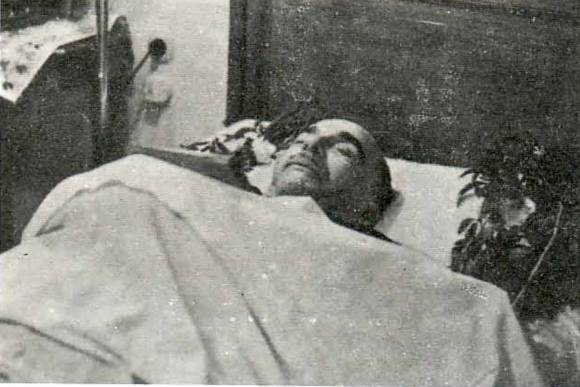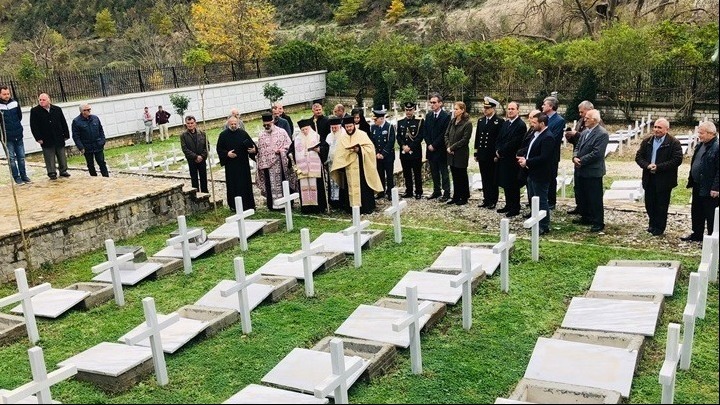Why is it called a trilogy when it has four parts? Shouldn’t it be called the Mauthausen Tetralogy?
The 1995 CD version included more songs by various other composers
Cyprus in World War 2
The British gained Cyprus in 1878, as part of a deal with the Ottoman Empire, because of the British support during the Congress of Berlin. Cyprus’ strategic location near the Suez Canal made the island important for the British Colonial Empire.
In Cyprus, the newly arrived British faced two opposing nationalisms. The Greek-Cypriots (80% of the population), were campaigning in favor of “Enosis”, i.e. the Union of the island with Greece. The Turkish-Cypriots (18% of the population), especially after the establishment of Mustafa Kemal’s national movement and the Treaty of Lausanne in 1924 (in which Turkey explicitly relinquished any claim to Cyprus) were supporting that if the British were to leave Cyprus, the island should be “returned” to Turkey.
The situation in Cyprus in the beginning of 1940’s was depressing. After the 1931 revolt of the Greek Cypriots against the authoritarian rule of Sir Ronald Storrs (the real life inspiration for “Mr. Dryden” in “Lawrence of Arabia”), a strict dictatorship was imposed, “ influenced by the political philosophy of Mussolini ”, according to a functionary of the British Colonial Office, in 1938. The political leaders of the Greek Cypriots, from all political spectrums, were jailed or exiled. The Church of Cyprus, the main political representation of Cypriots since 5th c. AD, was blocked by the British, who forbade elections for new archbishop, since the death of the latest one in 1933. Political parties were forbidden, elections were abolished, Habeas Corpus was abolished, the communal authorities were directly appointed by the governor, the Greek flag was forbidden to be publicly displayed, the British authorities intervened with school curriculum, to suppress Greek nationalism and create a new “Cypriot-only” identity, loyal to the Crown. The only legal associations left were the trade unions and the football (soccer) clubs, though they remained under strict British control. This period was named “Palmerokratia” (“Palmerocracy”, rule of Palmer, the Governor Sir Herbert Richmond Palmer).
The local economy was worse than the political situation, since 1929 Crush. Cyprus was a farming economy, and 82% of farmers were in huge debt. Between 1927 – 1930 banks had given loans of £ 390.338 (£ 49.628 were loans from the government). Most of them were used to pay loan sharks. Agricultural debts were over 3 million British Pounds. Divestments and auctions were daily (18.000 mortgaged real estate was sold; 19.500 real estates were auctioned). By forced divestments, c. 550.000 acres were sold, along with a million fruit trees and 8.000 homes. The newly landless people were either migrating in Britain or moved to the cities working for petty wages or worked in the mines (copper is named from Cyprus). The latter worked under dangerous conditions and died in large numbers, either because of mining accidents or because of cancer. The political exploitation of the British was accompanied by the economic exploitation of usurers and mining companies.
This condition was still in effect when WW2 started. The majority of the people heard the news of the war with indifference. Nevertheless, as with WW1, a considerable number enlisted in the British Army, because the salary could feed their families. Cypriot mules are one of the best mules’ breeds and were much needed and valued by the British Army for their transport. A few days later, on September 8, 1939, the Governor of Cyprus called for the enlistment of 500 Cypriots in the British Army as motorists or engineers, scribes and cooks, preferably unmarried, aged 18 to 30 years old. By October 6, 1939, 54 Cypriot soldiers had been selected, on strict criteria, to depart for Egypt and from there to France.
In February 1940, the Cyprus Regiment was officially formed. It was consisted of one Infantry battalion, along with Engineers, Transport and Pack Transport Companies. From 1939 until August 15, 1945, 16.624 soldiers were enlisted in the regiment. The first enlisted soldier of the Regiment was the Turkish Cypriot Nevzat Halil from Nicosia, with number CY 1 and date of enlistment October 2, 1939. The Cyprus Regiment was the first British Colonial unit that fought in WW2, in the Western Front, and it distinguished itself during the evacuation of Dunkirk.
Cypriot Troops Over There (1940), by Pathe
In June 1940, the “Cyprus Volunteer Force” was created, having the role of a Cypriot Home Guard. This force offered services in fortifications, military supplies and guarding of warehouses, while it also served as an Engineer Corps, following enemy (mainly Italian) air bombardments as well as Technical Corps. After the occupation of Crete in June 1941, and the danger that Cyprus was going to be Germany’s next target, the men of the force were gradually supplied with military uniforms and weapons after a short training course. 4450 Cypriots, officers and soldiers, were included in the “Cyprus Volunteer Force”.
More troops in Cyprus (1941), by Pathe
Cyprus On Alert (1942), by Pathe
In WW2, hundreds of Cypriot women volunteered in auxiliary services in the British Army and the RAF. This was the first massive participation of Cypriot women in the public life, and they had to overcome centuries-old prejudices and attitudes about their social status. Among the volunteers were members of well-known Cypriot bourgeois families, but mostly employees, nurses and maids. We know the names of 117 Cypriot female volunteers. One of them was killed in September 1943 and is buried in a military cemetery in Egypt.
These numbers are impressive, given that Cyprus had less than 400,000 inhabitants (347,959 inhabitants at the last pre-war census of 1931).
In addition to Cypriots living in Cyprus, it is estimated that at least 500 Cypriots living as immigrants in Britain and Egypt were enlisted in other units of the British Army. After the fall of Greece in May 1941, Cypriots of Egypt joined the Greek armed forces in exile. Cypriots also joined other countries in Allied armies during World War II: 306 Cypriots living in USA enlisted in the US Army and 135 Cypriots in Australia enlisted in the Australian Army.
At the same time, the British administration begun taking re-approximation measures concerning the Cypriots. The British contacted the surrogate archbishop Leontios, they appointed a number of Cypriots to senior positions in the public service and opened a few jobs to partially combat unemployment (road repairs, telephone and electricity installations construction, small fortifications). Also, by Governor’s Degree, all agricultural debts were reduced to one third and interest rates fell to 5%.
Nevertheless, the life in Cyprus was calm and far from any worries for the war (apart the families of the conscripted), until October 28, 1940. The news that Italy attacked Greece caused a massive popular rising. Church bells were rung again, Greek flags were demonstrated, fundraisings were made to financially support Greece (the Greek government announced in January 1941 that it received £ 70.000 from Cypriot fundraisers) and huge crowds headed to the British enlisting offices and to the Greek consulate, to enlist in the British and Greek armies. More importantly, the Church and the remaining Greek-Cypriot leadership, declared that the cooperation of the Cypriots with the British authorities was essential for the Greek and the Allied victory. From now on, the war effort became the main concern of the people.
Because of the Greco-Italian war’s beginning, November 1940 was the month with the highest enlistment during WW2: 921 men, the 7,5% percent of all enlistments.
For political reasons, the British did not help the enlistments of Cypriots in the Greek Army. Since the private transport to Greece was very difficult during war time, only 94 Greek Cypriots managed to go to Greece, through their own expense. Also, around 50 Cypriots living in Greece, mostly university students, enlisted in the Greek Army as well. The rest who failed to enlist in the Greek Army, ultimately joined the Cyprus Regiment.
As a compromise for the Cypriots, the British authorities in 1941 terminated the oppressive regime of the 1930’s and allowed again the existence of political parties and the holding of municipal elections. So, on April 14, 1941, Greek Cypriot communists founded the AKEL (“ Progressive Party of Working People ”) party. On June 16, 1943 AKEL called on its members and all the people to join the British army to fight fascism / nazism. This declaration was widely influential and 800 members of AKEL, including 11 Central Committee members, were enlisted and joined the battle fronts.
Until the German invasion in Greece, in April 1941, around 3,000 - 4,000 men of the Cyprus Regiment (Greek and Turkish Cypriots), mostly Sappers and Engineers, were transferred in Greece, as they had the advantage of knowing the language and the territory. Although the Cypriot units did not fight as combat units, they nevertheless suffered enormous casualties: 2256 men; 5 KIA, 2 wounded, 1426 MIA and 823 prisoners (600 alone caught in Kalamata, trying to escape along with other British soldiers), according to the first official calculations, in October 1941. Cypriots were massively arrested in Crete as well, since the British first evacuated the combat units. The prisoners were gradually assembled in Thessaloniki, from where they were transported by rail to various concentration camps in Europe. By the end of the war 35 Cypriot prisoners of war died out or were executed. The large number of MIA is explained by the fact that the Cypriots, in sharp contrast with the British or the ANZACs, could take off their uniform and mingle with the Greeks without the danger of detection. The Greek and Turkish Cypriots who didn’t managed to escape Greece after the invasion, joined the various Resistance Groups and the survivors return in Cyprus after 1945. It is difficult, though to estimate cohesive numbers.
Interestingly, during the final stages of the German Invasion, the Greek Government requested from the British to move its seat to Cyprus. The British, knowing that such move would greatly strengthen politically the movement of Enosis, declined, with the pretext that this move would provoke the Germans to invade Cyprus, and the Greek Government in exile was moved to Egypt.
As the war continued, the British administration kept the policy of rapprochement with the Greek Cypriots. On January 31st, 1943, Winston Churchill visited Cyprus, and had several meetings with the command of the Cyprus Regiment, the caretaker Archbishop Leontios and other politicians from both communities.
For the rest of the war, the Cyprus Regiment fought in North Africa, participating in the battles of El-Alamein, and in East Africa (Battle of Keren), where the Cypriot mules were proven extremely valuable on the steep, stony and narrow mountain trails. In 1944, the Regiment was transported in Italy. Initially, it was assigned with the Poles, the 5th Kresowa Infantry Division and 3rd Carpathian Rifle Division and later with Indian units, the 4th Indian Infantry Division and the 10th Indian Infantry Division. In Italy, the Cyprus Regiment became famous for its reliability, it fought in Monte Cassino, and along with the Indians reached the Rubicon. Both the Polish and the Indian commanders cited their gratitude for the Regiment in paper.
After the end of WW2, the Cyprus Regiment was transported to Palestine, until 1948 and the Israeli Declaration of Independence, when it returned to Cyprus. The unit was dissolved in 1950.
In total, the number of the fallen Cypriot soldiers, Greeks and Turks is 374. Tombs and cenotaphs of Cypriot soldiers of the British Army who were killed in 1939-1945 exist in Cyprus and in various cemeteries in 23 other countries (Egypt, Belgium, France, Germany, Switzerland, Greece, Eritrea, United Kingdom, India, Israel, Italy, Kenya, China, Lebanon, Libya, the Netherlands, Poland, Serbia, Singapore, Sudan, Syria, Tunisia and the Czech Republic). Cypriot fallen are buried in 71 military cemeteries and war memorials. The largest dispersal of Cypriot tombs is in Italy: 55 “Cypriot” World War II military tombs are found in eighteen different cemeteries. Most of the Cypriot soldiers are buried in the cemeteries of Greece, 100 in total, indicating the large participation of Cypriots in the Greek campaign of 1940-1941. 79 Cypriots are buried in twelve Egyptian military cemeteries: This is explained by the Cypriot participation in the North African battles and the permanent presence of a “Base-Depot” of the Regiment in Egypt. A significant number of fallen Cypriot soldiers, 57 in total, are buried in the two Nicosia military cemeteries. They are mainly victims of hostile bombardments or soldiers who have died in various accidents or died in hospitals from illness. In Israel, 18 men of the Regiment are buried, while most, if not all, of the 17 Cypriot soldiers resting at the Prague military cemetery in the Czech capital were held as prisoners of war. Finally, there is one Cypriot tomb in India, in Kenya, in Singapore and in Hong Kong.
The legacy of WW2 in Cyprus was tightly connected with the developments in Greece and the Middle East. From one side, the Greek Civil War reached Cyprus and its impact tore apart the Greek Cypriot society in communists and anti-communists, and in Middle East the withdrawal of the British from Palestine, made Cyprus more important than ever for the British, by establishing permanent military bases and intelligence posts.
Concurrently, the global wave of decolonization, empowered the Greek Cypriots, communists or not, and they intensified their struggle for self-determination and Enosis with Greece. This scenario terrified the Turkish-Cypriots, who organized themselves and seek assistance from Ankara. The decade from 1945-1955 was a decade of political tension, which exploded in 1955, when the Greek Cypriot organization EOKA, began an armed anti-colonial struggle against the British, which ultimately led to the creation of the independent Republic of Cyprus.
Sources
-
“Cypriots among the forgotten troops of Dunkirk”, August 6, 2017 (english)
-
Papapolyviou Petros, The Cypriot volunteers of WW2: Registers, Files and the blood price , Nicosia, 2012. (Greek)
The cap badge of the Cyprus Regiment

Inspection of the first Cypriot soldiers who left Cyprus for Egypt on October 13, 1939, by the then Governor of Cyprus, Sir William D. Battershill. In the foreground is a Cypriot private first clas, out of six in that group (two Turkish Cypriot and four Greek Cypriots).

Cypriot volunteers in the port of Piraeus, enlisted in the Greek Army, January 1941
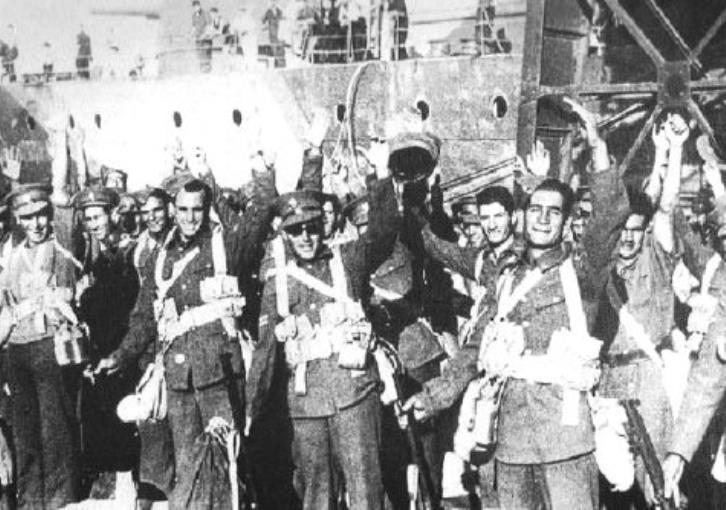

Meeting of caretaker Archbishop Leontios with Winston Churchill, Nicosia, February 1, 1943.
Men of the Cyprus Regiment training at their depot in Cyprus, September 1940

Churchill inspecting the Regiment in Nicosia airport, January 31, 1943

Winston Churchill in the Governor’s House, Nicosia, February 1, 1943

January 29, 1941: Metaxas dies
Prime minister/dictator Ioannis Metaxas, died at 06:20 from a of a phlegmon of the pharynx, which subsequently led to incurable toxaemia. King George II did not make a single change to the regime and appointed as prime minister the governor of the Bank of Greece, Alexandros Koryzis. In reality, Koryzis is a mere figurehead, from now on the king assumes full executive powers. The anglophile king will turn the country towards Britain, without having the reservations of Metaxas about the forecoming German invasion.
More importantly, the indifference of Metaxas to provide for his succession and the insistence of the king to retain the regime, will soon create a vacuum of power in Axis occupied Greece and will have cataclysmic effects in the shaping of the future Greek Resistance.
Announcement
The people of Corfu is informed again that they must surrender, until May 7, to the nearest German department or to the president of the community the following:
WEAPONS OF ALL KINDS (rifles, shotguns, revolvers, machine guns etc)
AMMUNITIONS (explosives, grenades, gasoline, etc)
Military transport means and their accesories
RADIOS (transmitters and receivers, telephones, wires, optics, military generators)
ALL THOSE WHO WILL SURRENDER THE MENTIONED ITEMS WILL SUFFER NO CONSEQUENCE
The presidents of the communities are responsible for carrying out the announcement, and for delivering the items to the nearest German department.
If any of the mentioned items will be found after the deadline, all male members of the household WILL BE SHOT and the house will be destroyed
THE MILITARY COMMAND
Corfu, April 27, 1944
Hello everyone im new here.
Since we are talking about Greece during world war 2…
Here is a photo i colorized myself
The guy with the glasses in the center is greek photographer Δημήτρης Χαρισιάδης Dimitris Harisiadis (1911-1993)
You could have made some changes with the shadows by giving them a slight hint of blue from the sky and the light from the ground. The uniforms are the worst offenders in that regard. However, I do love the way you colored the ground. Keep up the good work and welcome to the TimeGhost Army. 
Yea , i know… its not the best work ever. I made this one 2 years ago
I’ve stopped colorizing photos for the past 10 months (since i realized im not that great at it  )
)
Oh, why did you stop? I made crappy ones myself in the past. The more you colorize, the better your results. Historical accuracy and physics are the things you must focus on and be very careful of when colorizing. I’ve seen many colorized photos that are historically accurate, but the color physics were off-putting and vice-versa.
I’m new around here and I’d just like to say that this is a great thread. Bravo, great job to @avalantis. Well done, Sir.
Thx! 


"A burial ceremony for 20 Greek fallen soldiers of the Greco-Italian War took place on Wednesday, February 12, 2020 at 11:00 am at the Kleisoura (Këlcyrë) Military Cemetery in Albania, according to a statement from the Greek Foreign Ministry.
The remains of the fallen were found in the context of the implementation of the 2009 Greece-Albania bilateral agreement on the search, exhumation, identification and reburial of Greek fallen soldiers in war operations in Albania in 1940-1941.
Representatives of the Greek Ministry of Defense, the Greek ambassador to Tirana, the Greek consul general in Argirokastro (Gjirokastër), as well as representatives of the Greek minority in Albania, attended the ceremony, presided by the Bishop of Argirokastro/Gjirokastër.
The Greek Foreign Ministry is pleased that 80 years after their sacrifice, the souls of Greek fallen soldiers will rest in peace and welcomes the cooperation with the Albanian side on this particularly sensitive and humanitarian issue, stressing the importance it attaches to continuing work. on the field and the full implementation of this bilateral agreement between Greece and Albania."
In May of 1941, the Bulgarian administration officially takes over almost all parts of Greek Thrace; from the Struma river in the west to the cities of Deadegac and Porto Lagos in the East. The region is unified under the new administrative region of Belomorie (“White Sea Region”) and the regional capital is in Xanthi.
Kavala port becomes the HQ for the new Bulgarian “White Sea Fleet”. And it functions up until late 1944:


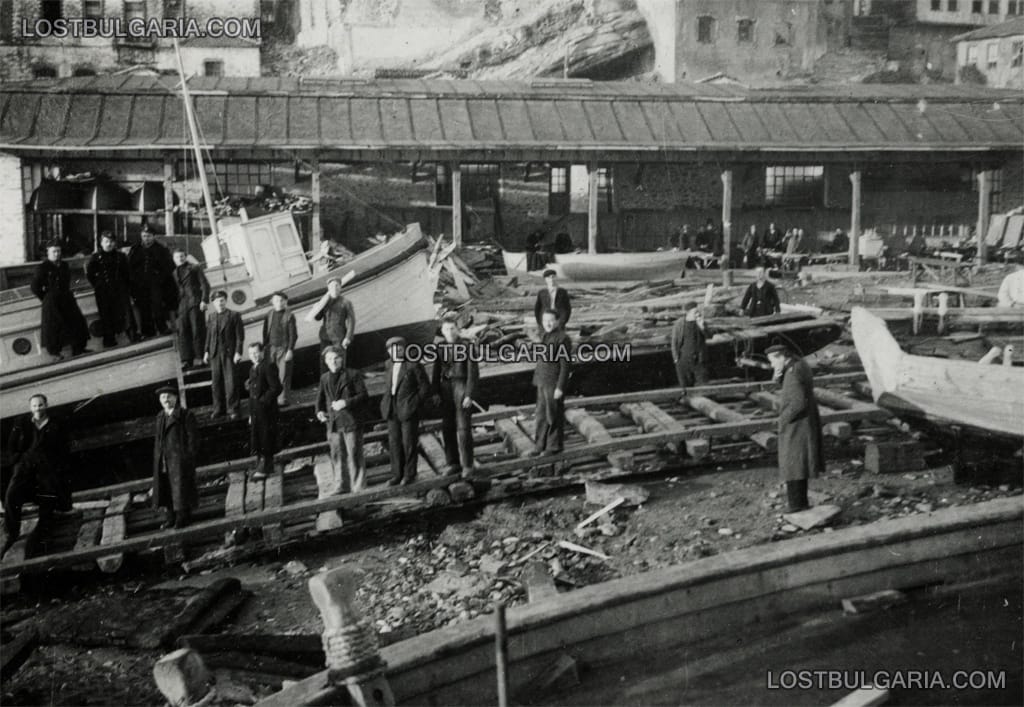

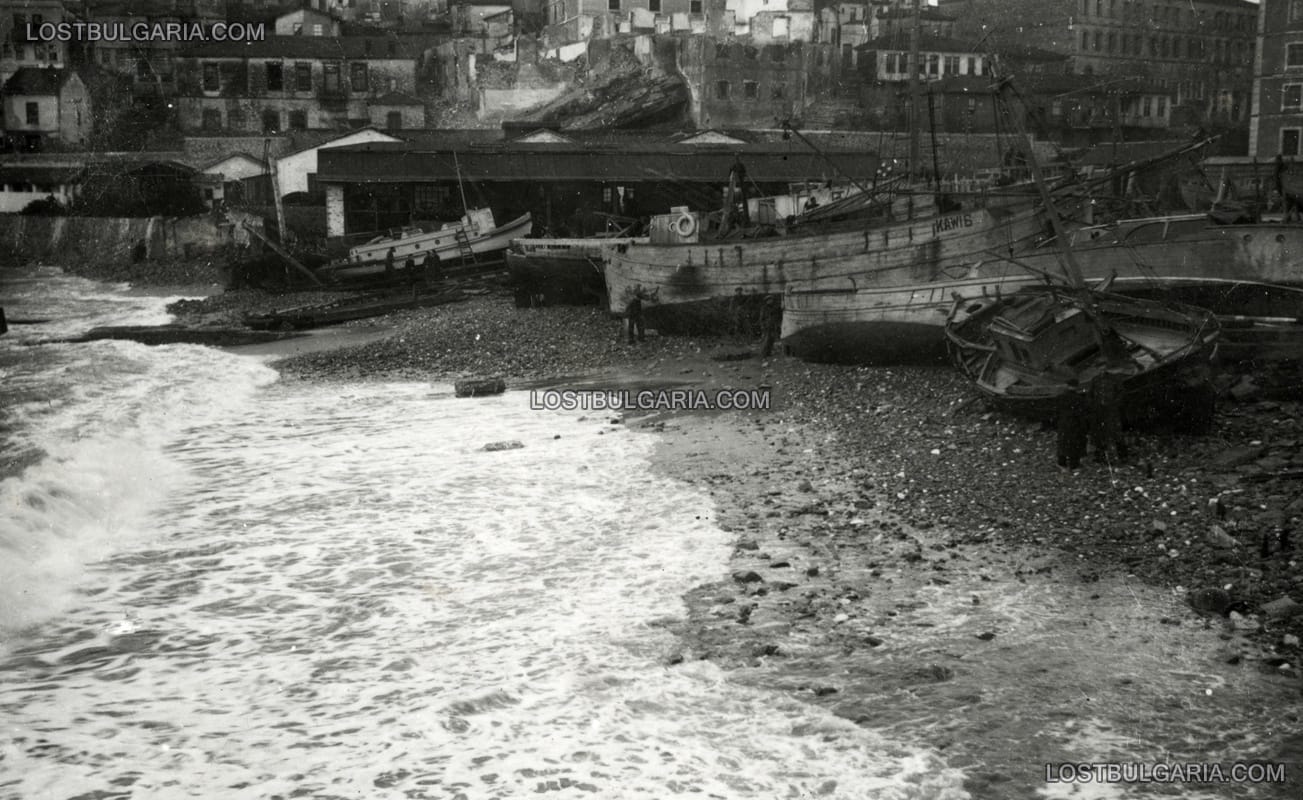
apart the Greco-Turkish borders, ie. 2/3 of the Evros regional unit which remained under German administration.
Also, Bulgaria controlled Eastern Macedonia
The migration of the Greek navy
In sharp contrast with the Greco-Italian War, where under any circumstances, the Greek navy carried out its duties, the situation changed dramatically on April 6, 1941, when the Germans launched their invasion against Greece.
From day 1, the Luftwaffe managed to gain air-supremacy (700 warplanes vs 250-300 British/ANZAC/Greek warplanes) and from the same day neutralized almost every major Greek port, either by destroying it, or by mining it, a feat that the Italian air force failed for 6 months. Especially the bombardment of Piraeus port, the largest of the county, minimized the operation capabilities of the allied army, as it negated any chance of further reinforcements.
Metaxas built a regime centralized around him and he didn’t provide for his succession. Therefore, after his death in January, the leadership and the state machinery started to disintegrate, from top to bottom. From the public services to the Army, the Air Force, the security forces, only the Navy kept its structure and its discipline, and finally left the country as a unified, coherent force. Already before the German invasion, Rear Admiral Alexandros Sakellariou, Chief of the Navy General Staff started to issue orders, from March 23, about the movement of materiel “to the south”.
After fierce but short fighting, the Metaxas Line was overrun, the Greek army in Albania retreated to avoid encirclement, and the British line in Haliacmon river was proved too thin for the Germans. Soon, the Greek generals sought to negotiate with the Germans, contrary to the orders of the Government and the General Staff, and the Greek army either collapsed or surrendered. In the chaos that followed, the British and ANZAC troops could only withdraw further south, until they reach Crete.
The navy, instead of leaving from the range of the Luftwaffe, was ordered to keep the ships, especially the new destroyers, near the capital, to facilitate the allied retreat and the transport of the cabinet members. So, most of the ships try to hide in estuaries and similar places, while they continue their escort duties for convoys.
As the military situation deteriorated, so was the civilian one. Most of the generals and the cabinet members were concerned about retaining the king’s favor to retain their positions post war and how they could leave the country with most of their possessions. So, it seems they stalled the fleet’s departure, and their presence in the ships, along with their valuables, caused the discontent of the crews and in some cases threatened mutinies.
Rear Admiral Sakellariou, by the April 10, presented a memorandum to the cabinet, concerning the migration of the navy to Alexandria, “ under the pressure of the development of the war ”. His proposals were accepted and in the next day the Supreme Naval Council issued top secret order No. 927. According to it:
(a) The main combat ships of the fleet (destroyers and submarines) would be prepared for Alexandria while the Averof and torpedo warships would be relocated to Souda.
b) By the signal “Messolonghi”, all fortresses and installations would be destroyed. However, it was explicitly stated that the facilities of the Radio Service, the workshops of the naval bases and the shipyards would remain intact in consultation with the allies.
c) By the signal “Hellas” the war files would be burned.
(d) By the signal “Hera” any personnel who could not leave would be dismissed and any vessel which could not sail would be destroyed.
An indicative of the situation was the fate of legendary armored cruiser George Averof, the flagship of the Greek Navy. When news reached that the navy command was about to scuttle the ship to prevent its capture, the crew mutinied, they cut through a closed harbor-boom with axes and handsaws to let the vessel escape, and their commanding officer dramatically embarked up a rope ladder to join them as the vessel was underway to Alexandria.

“RHNS Georgios Averof” in camo paint, RN Bombay Station, 1942, while serving under UK Royal Navy Command.
On April 18, Prime Minister Koryzis committed suicide, and Rear Admiral Sakellariou was appointed Minister of Naval Affairs and Deputy Prime Minister, retaining his military office.
Most of the allied soldiers were successfully evacuated from the mainland to Crete, but the cost was terrible: From April 4 to 25, 20 units out of 36 of the Greek Navy, were sunk by the Stukas, amongst them the destroyers “King George”, “Psara” and “Hydra”, with hundreds of killed and injured.
Two exceptions were the destroyers Aetos and Spetsai. In Aetos, the captain and two senior officers of the ship resigned, and a mutiny ensued. Some of the mutineers damaged the anti-aircraft guns (not beyond repair). Lieutenant commander Ioannis Toumbas took over the ship, and told to the sailors that he wanted to arrest no one, but “ any member of the crew who does not understand his duty must leave the ship now. Whoever stays, he will continue to fight for the fatherland ”. All officers and NGOs, apart three petty officers, left, as half of the sailors. As he was leaving, the chief accountant of the ship was caught with a suitcase containing the ship’s money, he was arrested, tried and executed. In Spetsai, the mutiny was suppressed with harder measures.
Until late April, 16 ships managed to reach Alexandria and were thus placed under British command: The armored cruiser Averof, nine destroyers; Queen Olga, Spetsai, Aetos, Kountouriotis, Ierax, Panther, Aspis, Nike, and Sfendoni, five submarines; Nereus, Triton, Papanikolis, Glaucus and Katsonis and the repair ship Hephaestus. Despite the request of Rear Admiral Sakellariou for the participation of the Greek Navy in the forthcoming Battle of Crete, Andrew Cunningham deemed the vessels in poor condition from the war operations and having outdated equipment. So, they were sent to the dockyards of Bombay and Calcutta for repairs and update.
Those 16 ships, along with the remaining Greek merchant fleet, became the core of the Greek Navy-in-exile, which continued to fight around the globe until the final victory.

Queen Olga was the most modern ship of the Greek Navy which survived the battle of Greece. She continued to participate in war operations until she was sunk by German bombers at Leros island, on September 26, 1943, with the loss of 72 men
- Bulgarian anti-fascist guerrillas in Didimoticho,Greece. These pro-Communist guerrillas worked closely with ELAS (Greek People’s Liberation Army) units during the last two years of the Bulgarian occupation of Eastern Macedonia and Thrace.
March 1941. Australian soldiers and British Royal Navy officers on the Acropolis

March 1941. Australian soldiers on the Acropolis. (Caryatids). -AWM

April 1941. Disarmed Greek soldiers after the capitulation of the Epirus army, on a train wagon trying to return home.

April 1941. Half-sunk German Panzers tries to cross the Pineiós river

April 1941. Pictures of disaster in the port of Piraeus,Greece, following the bombing of Luftwaffe. -Franz Peter Weixler.

Greece mourns for Manolis Glezos, a legendary member of the Greek Resistance, who died today, aged 97, from heart failure.
Born in the village of Apiranthos, Naxos on September 9, 1922, Glezos moved to Athens in 1935 together with his family, where he finished high school.
On the night of the 30th to the 31st of May 1941, together with his friend Apostolos Santas, they climbed the Acropolis cliffs, and tore apart the swastika flag raised on Parthenon, with only “weapons”, a lantern and a knife, in what is viewed as the first act of Resistance is Axis occupied Greece. Both have described in subsequent interviews how they did the act without been spotted, and how they hid a piece of the flag on them … The view of the missing flag provoked the annoyance of the Nazis and gave courage to the Athenians.
They were sentenced to death in absentia, but since their identity was not discovered, both of them were jailed from the Nazi and the Italian authorities without being executed, as they became fully fledged members of EPON, the youth wing of EAM. Because of the tortures he suffered, he contracted tuberculosis. Glezos’ younger brother, Nikos, was executed by the Nazis in May 1944.
After the liberation of Greece, Glezos took part in the Battle of Athens against the British. He was one of the leaders of the demolition team who planted dynamite below the hotel Grande Bretagne, the British HQ during the battle. Ultimately, the operation was called off when it became known that Churchill came in Athens, staying in the hotel, in his attempt to monitor the crisis.
During the Civil War and post-war Greece he became a journalist and editor in communist and left leaning newspapers. He was repeatedly hunted by post-war Greece. In 1948 and 1949 received the death penalty. After international pressure his sentence was commuted to imprisonment in life, and he was released in 1954. Despite his time in jail, he was elected MP in 1951, included in the left party EDA. In 1958 he was imprisoned again, accused for espionage, and he was released in 1961. He was imprisoned again in 1967, by the Far Right coup of the Colonels. He was released in 1971.
Manolis Glezos’ sentences, from the Second World War to the Greek Civil War and the Regime of the Colonels totals to 11 years and 4 months of imprisonment, and 4 years and 6 months of exile.
After the restoration of Democracy, in 1974, he was repeatedly elected MP, he became member of the European Parliament in 1984, major of his birth village in Naxos in 1986, he participated in the anti-american demonstrations in Belgrade during the 1999 bombings, and he was elected again in the European Parliament in 2014 with SYRIZA party, with 438.000 votes, the highest of all canditates. He participated in the Paris march against the Charlie Hebdo terrorist attack, and he took an active role against the austerity policy in Greece, and he supported the “No” vote in the 2015 bailout referendum. He resigned from MEP in 2015.
Poster during the Resistance, depicting their feat

Manolis Glezos (left) and Apostolos Santas (right), after WW2
